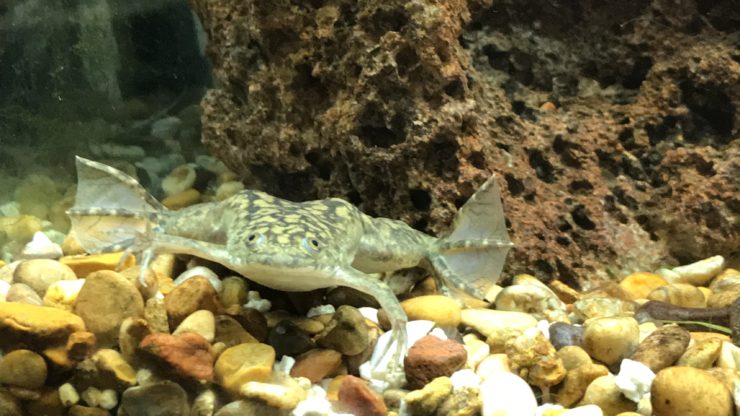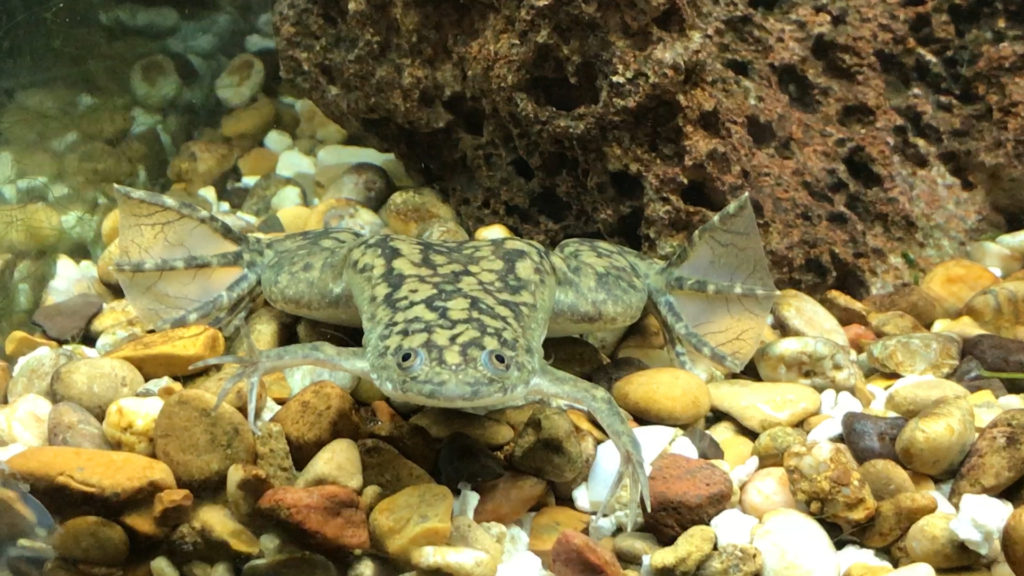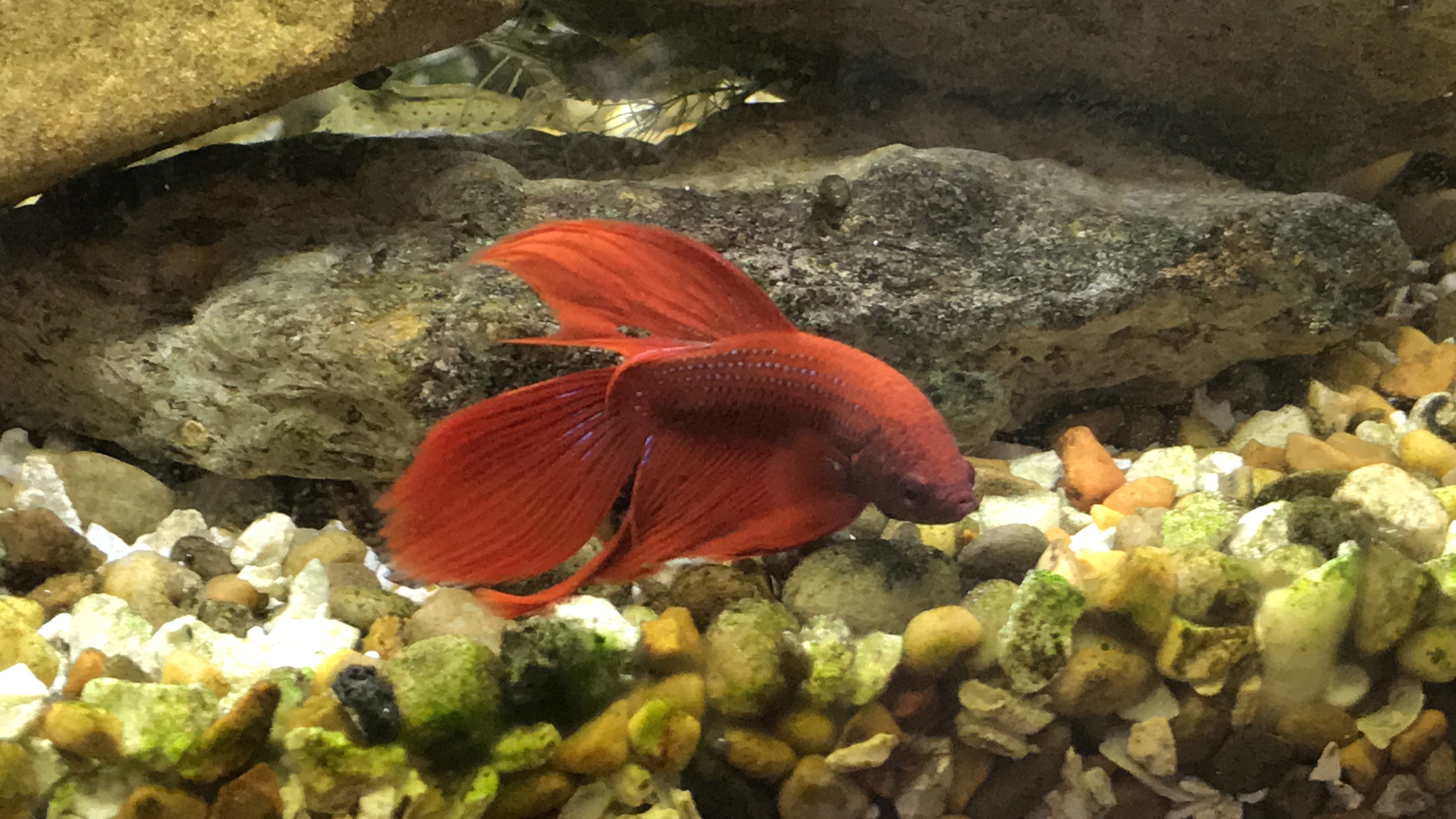
Posted on by admin
African Clawed Frog Care Guide
The African Clawed Frogs are not to be confused with African Dwarf Frogs. There are a few big differences between the two. First of all, when looking at their front legs, you will see that they are not webbed. Also their claws are their back feet are black tipped, where as the African Dwarf Frogs are not. It’s important to know the difference sins the African Clawed Frogs are more aggressive than the African Dwarf Frogs.
Scientific name: Xenopus laevis
Size: 2 – 2.5 inches for males, females up to 4.5 inches
Temperament: Agressive
Care Level: Easy
Diet: Carnivore/Scavenger – but will eat mostly anything
pH: wide range
Temperature: 60°F – 80°F (16°C-27°C)
Swimming Area: All Levels but Top and bottom levels mostly
Minimum Tank Size: 10 gallon for 1 frog
Lifespan: 20-30 years in captivity
Natural Habitat
Clawed Frogs are Native to Sub-Saharan Africa living on the western boundary of the Great African Rift. Some of the Native people use the frog in many ways. For example, because they are considered a great source of protein they are used as food. They are also used as an aphrodisiac, as well as a medicine to treat infertility.

Tank Conditions
African Clawed frogs have been kept as pets and research subjects since as early as the 1950s. They are very hardy and live a long time – they live up to 20 to 30 years in captivity. African clawed frogs are voracious predators and scavengers and can adapt to many environments
What Do African Clawed Frogs Eat
Clawed frogs will eat anything they can fit in their mouths. Clawed frogs are carnivores as well as scavengers and will eat both living and dead prey including fish, tadpoles, crustaceans, annelids, arthropods. Even though they are technically carnivores, they eat algae pellets and whatever else I put in the tank.
African Clawed frogs are fully aquatic and they use their eyes to catch their food, but they rely on mostly their keen sense of smell and their lateral line to find prey rather than eyesight as their main hunting tactic unlike other frogs who depend mostly on sight.
Clawed frogs still see using their eyes and will stalk prey or watch predators by sticking their heads out of the water. Clawed frogs will dig for worms and other food hiding on the bottom of the tank.
They can’t extend their tongues like other frogs, so clawed frogs use their hands to grab food and shovel it into their mouths.
When they’re not eating, clawed frogs hang out motionless at the bottom of the tank or float at the top with their heads sticking out.
Adult frogs are scavengers, eating living, dead or dying pieces of animals and organic waste, including insect larvae, insects, crustaceans, small fish, tadpoles, worms, snails and whatever happens to be available.
They have a hearty appetite and will attack anything that passes in front of them.
These frogs find their food using extremely sensitive fingers, an acute sense of smell and their lateral line system. A special pump helps these frogs suck food into their mouths.
The claws on their hind feet tear apart larger pieces of food.
They will also eat a number of different types of food easily found in stores and on line.
For example:
Pellets
bloodworms
Xtreme Aquatic Foods Nice – https://amzn.to/3AX4FtR
Xtreme Bottom Wafers – https://amzn.to/3HsD06e
Omega One Veggie Pellets – https://amzn.to/34siYKC
Omega One Sinking Wafers – https://amzn.to/3HsLudx
Sexing
Male frogs are smaller and slimmer than females, while females are larger and rounder.
Males have black patches on their hands and arms which aid in latching onto females.
The eggs of the females are inside their body near their hips, so they have hip-like bulges above their rear legs where they keep their eggs.
Breeding
These frogs are sexually mature in 10 to 12 months.
Mating can occur at any time of year but is most common from early spring to late summer, depending on location, and can take place up to four times a year. They don’t have vocal cords, but males can still vocalize to attract females.
Mating usually happens at night in stagnant water, and lasts three to four hours.
The male grabs the female around the pelvic region, which is a common mating position in which the male grabs the female from behind.
The female lays between 500 to 2,000 eggs.
Sticky jelly around the eggs causes them to stick to objects such as sticks, rocks and other material underwater.
Eggs hatch within a week or so and tadpoles are born. They are usually less than 1/5 of an inch (2/5 of a centimeter) long.
The total change from egg to small frog takes about six to eight weeks.
Adults aren’t good parents and can eat any young they can get their hands on.
Tank Mates
They will eat anything they can so bigger, faster fish is they key to a happy tank.
I have Bala sharks, Siamese algae eaters, red tailed sharks, Pictus cats and Plecos in the tank with the frog. Other bigger community fish or medium aggressive fish would be fine.
I wouldn’t recommend big Cichlids that will eat the frog, nor small fish that the frog will eat.
If it will fit in the frog’s mouth, it will consider it as food.
I would NOT recommend any small bottom feeders since they can be sitting ducks for the frogs. I had a family of Bumblebee catfish that I thought would survive but they are no longer there. That was a bad mistake.
FUN FACTS
At times, when its pond dries up, the African clawed frog can burrow in the mud and may lay dormant for up to a year. The African clawed frog was the first vertebrate cloned in a laboratory. Their skin produces a type of antibiotic that heals wounds rapidly, presumably a useful adaptation in the stagnant, microbe-filled waters where they live. – Smithsonian National Zoo and Conservation Biology Institute
